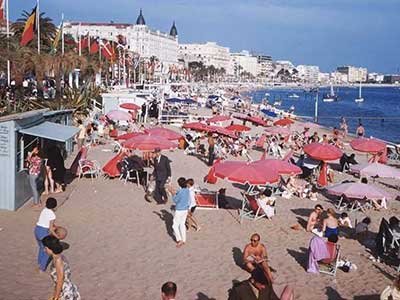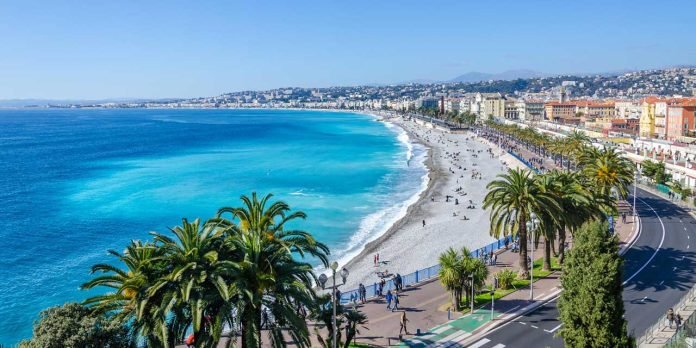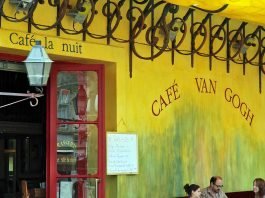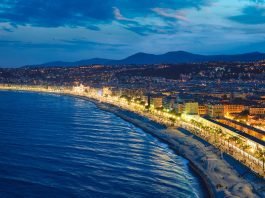From the allure of Cannes’ red carpet to the simple charm of a Saint-Tropez fishing village, and from the art galleries of Nice to the secluded beaches of Antibes, the French Riviera promises a rich and fulfilling escapade, marrying the laid-back Provençal spirit with an undeniable touch of glamour. Whether you are a sun worshipper, a history enthusiast, a gastronomic adventurer, or an art connoisseur, the Côte d’Azur is a coastal paradise that invites you to immerse in its myriad shades of blue..
History of the Riviera: From Greek Colonists to Roman Influence
Long before it became a playground for the rich and famous, the Côte d’Azur had its first brush with grandeur through the Greeks. In the 4th century BCE, Greek mariners from Phocaea (in today’s Turkey) established a settlement they named Nikaia, now known as Nice. They were drawn by the natural harbour and the area’s fertile land.
Following the Greeks, the Romans too set their sights on this alluring coast. In the 2nd century BCE, the Romans made their mark, establishing several towns such as Cemenelum, now Cimiez (a suburb of Nice), which became the capital of the Roman province Alpes Maritimae. Antipolis (Antibes) was another important Roman settlement. The ruins of Roman amphitheatres, baths, and villas, such as those at Fréjus and Nice-Cimiez, still stand today as testament to this era.
The Belle Époque: The 19th Century Saw This Coast Transform
The turn of the 19th century marked a pivotal era for the Côte d’Azur, known as the Belle Époque. During this time, winter tourism became a trend among the British aristocracy. Lord Henry Brougham, a former British Lord Chancellor, stumbled upon Cannes when he was unable to enter Italy during a cholera outbreak in 1834. Enchanted by the area, he built a villa and became a regular winter visitor, drawing other British nobles to follow suit.
The construction of the railway line that connected Paris to Nice in 1864 marked a turning point, opening up the region to tourists from across Europe. Grand hotels, like the Negresco in Nice and the Carlton in Cannes, began to spring up along the coast, as did ornate villas and gardens. The Riviera became the winter garden of Europe, a playground for the aristocracy and burgeoning bourgeoisie who were drawn by the mild climate, stunning scenery, and burgeoning cultural scene.
Modern Glamour: Post-WWII, the Region Became Synonymous with Celebrity Allure and Sun-Soaked Luxury

In the wake of World War II, the Côte d’Azur transformed again, this time into a summer destination. The 1950s and ’60s saw an influx of artists, writers, and Hollywood stars, lured by the region’s natural beauty, vibrant light, and laid-back lifestyle. Think of Picasso in Antibes, Brigitte Bardot in Saint-Tropez, and Grace Kelly in Monaco.
The Cannes Film Festival, established in 1946, played a significant role in this transformation, turning the quiet fishing town into a world-renowned hotspot for the global elite. Each year, the festival draws actors, directors, producers, and cinephiles from around the world, solidifying the Riviera’s reputation as a glamorous cultural hub.
Today, the Côte d’Azur is synonymous with opulence and style. Luxury yachts dot its harbours, and the coastline is lined with plush villas, five-star hotels, and exclusive beach clubs. Yet, despite its evolution, the Riviera has retained its intoxicating natural beauty – the same cerulean waters and golden light that have been drawing people to its shores for centuries.
Tourist Attractions and Activities: More than Just Sunbathing
Famous Festivals: A Celebration of Culture and Glamour
Cannes Film Festival
One of the most prestigious and celebrated film festivals in the world, the Cannes Film Festival transforms the tranquil town of Cannes into a bustling hub of movie magic. Established in 1946, the festival is held annually at the Palais des Festivals et des Congrès. It attracts filmmakers, actors, and cinema enthusiasts from around the world, all eager to see which film will win the esteemed Palme d’Or, the festival’s highest honour. Beyond the film screenings, Cannes during the festival is a place to see and be seen, with celebrities gracing red carpets and luxury yachts lining the harbour.
Nice Carnival
The Nice Carnival is one of the world’s largest and most colourful carnivals. Held annually in February, this two-week celebration is an explosion of vibrant parades, elaborate floats, giant puppets, and costumed performers. The Promenade des Anglais, Nice’s iconic seafront boulevard, becomes a stage where traditional flower battles—a unique and fragrant aspect of the festivities—are held, delighting locals and visitors alike.
Monaco Grand Prix
The Monaco Grand Prix is one of the world’s most famous Formula 1 races, renowned for its challenging circuit and stunning backdrop. The streets of Monaco are transformed into a racetrack, and spectators flock to the city-state to witness the thrilling competition. Held annually since 1929, this race is as much a social gathering as a sporting event, with luxury yachts and exclusive parties dominating the scene.
Retail Therapy
Nice
Stroll along Nice’s famous shopping street, the Jean Médecin Avenue, where you will find a mix of high-street brands, local boutiques, and delightful cafes. For a more unique shopping experience, venture into the Old Town (Vieux Nice), where narrow, winding streets are filled with quirky boutiques, art galleries, and vibrant markets like the Cours Saleya Flower Market.
Cannes
Cannes is a shopper’s paradise, especially for those with a penchant for luxury. The Boulevard de la Croisette, Cannes’ glamorous waterfront street, is lined with prestigious designer stores—think Chanel, Dior, and Louis Vuitton—as well as elegant boutiques offering high-end French Riviera style.
Nautical Adventures
Sailing
The Côte d’Azur, with its calm and crystal-clear waters, is a sailing haven. Whether you’re an experienced sailor or a novice, numerous companies offer sailboat rentals and charters. Take a day trip from Nice to the serene Îles de Lérins, or embark on a longer journey to explore the rugged Calanques near Cassis.
Jet Skiing
For those seeking an adrenaline rush, jet skiing is a popular choice on the Riviera. Rentals are widely available, particularly in larger towns like Nice, Cannes, and Saint-Tropez. Explore the coastline at speed, or join a guided tour to discover secluded beaches and hidden coves.
Yacht Chartering
To experience the French Riviera in the most luxurious way possible, consider chartering a yacht. From the ports of Monaco, Nice, Cannes, and Saint-Tropez, companies offer yachts of all sizes for hire, complete with crew. Glide along the coastline with the wind in your hair, sunbathe on the deck, and anchor in a secluded bay for a swim in the azure waters—it’s the epitome of Côte d’Azur glamour.
Churches of the Côte d’Azur
Nice’s Russian Cathedral: The Largest Russian Orthodox Cathedral in Western Europe
Officially known as the St. Nicholas Orthodox Cathedral, Nice’s Russian Cathedral is an unexpected jewel in the heart of the city. Completed in 1912 under the patronage of Tsar Nicholas II of Russia, it is a testament to the significant Russian community that once lived in Nice. With its vibrant, onion-shaped domes and ornate frescoes, the cathedral is a splendid example of Russian religious architecture. Inside, visitors are greeted by a serene atmosphere, intricate woodwork, and a collection of rare, historical icons, making it a spiritual as well as an architectural highlight.
Saint-Paul de Vence’s Collegiate Church: A Blend of Gothic and Romanesque Architecture
Nestled within the charming medieval village of Saint-Paul de Vence, the Collegiate Church, or Eglise Collégiale, is a harmonious blend of Gothic and Romanesque styles. Built in the 14th century, this church is home to a rich interior that includes a remarkable wooden statue of Saint Paul, beautiful altarpieces, and stained-glass windows that cast a magical light. The quiet and contemplative ambiance of the church complements the artistic spirit of the village, which has long been a magnet for artists and writers.
Museums and Galleries
Marc Chagall National Museum in Nice: Home to the World’s Largest Collection of Chagall’s Works
Dedicated to the work of Russian-French modernist artist Marc Chagall, this museum is situated in the serene Cimiez neighborhood of Nice. Opened in 1973, the museum houses the largest public collection of Chagall’s works, focusing especially on his biblical themes. The permanent collection includes more than 400 of his creations – including paintings, drawings, and sculptures. The museum itself, surrounded by a lush Mediterranean garden, is a work of art, designed in close collaboration with Chagall to ensure that the space complemented his vibrant, dreamlike paintings.
Fernand Léger Museum in Biot: A Tribute to One of the Pioneers of Modern Art
Located in Biot, a picturesque village between Nice and Cannes, the Fernand Léger Museum stands as a colorful tribute to one of France’s great modern artists. The museum, set amidst a lush garden filled with mosaics and ceramics, houses an extensive collection of Léger’s paintings, sculptures, and ceramics. Known for his bold use of color and graphic style, Léger’s work is celebrated through rotating exhibits and educational programs in this inspiring setting.
Antibes’ Picasso Museum: Housed in the Château Grimaldi, with Stunning Works by the Iconic Artist
Perched on the ramparts of Antibes overlooking the sparkling Mediterranean Sea, the Picasso Museum occupies the grand Château Grimaldi. In 1946, Pablo Picasso was offered the use of a section of the château as a studio; in return, he left all the works he created during his stay there (which includes paintings, drawings, and ceramics) to the city of Antibes. Today, the museum showcases these pieces as well as works by other modern artists. A visit here is not just about the art—it’s also about experiencing the space where Picasso worked, and the views that inspired him.
Provençal Delights: A Culinary Journey Through the Côte d’Azur
Traditional Dishes: The Essence of the Mediterranean
Bouillabaisse
Originally a fisherman’s stew made with the day’s catch, bouillabaisse has become a signature dish of the Riviera, especially in Marseille and its surrounding coastal towns. This rich and flavorful broth is simmered with a variety of fish, shellfish, fragrant herbs, and spices. It is traditionally served with a side of rouille, a garlicky mayonnaise, and crusty bread. Every chef has their own twist on this Provençal classic, making it a must-try for any food lover.
Ratatouille
Ratatouille is the quintessential Provençal vegetable medley. This rustic and hearty dish consists of tomatoes, aubergines (eggplants), courgettes (zucchinis), bell peppers, onions, and a generous blend of herbs such as thyme and rosemary, all simmered slowly until tender. Perfect as a side or a meal in itself, ratatouille encapsulates the fresh and vibrant flavors of the region.
Consider these restaurants for Provençal Delights (August 2023)
- La Mère Germaine (Villefranche-sur-Mer): This renowned restaurant has been serving traditional Provençal cuisine since 1938. It is famous for its bouillabaisse, a classic fish stew, and other seafood dishes.
- La Ferme de la Huppe (Grasse): Situated in the countryside near Grasse, this charming restaurant serves Provençal cuisine made with fresh local ingredients. Try their signature dishes like daube provençale (a slow-cooked beef stew) and tapenade.
Sweet Treats: Indulging the French Way
Tarte Tropézienne in Saint-Tropez
A true gem of the Côte d’Azur, the tarte tropézienne is a dessert that originated in Saint-Tropez in the 1950s. This delectable pastry consists of a brioche-like dough, sprinkled with pearl sugar, and filled with a rich and creamy mixture of pastry cream and buttercream. The tarte tropézienne was famously named by actress Brigitte Bardot while she was filming in Saint-Tropez, and it has since become a beloved staple of patisseries throughout the region.
Consider these restaurants for Sweet Treats (August 2023)
- La Tarte Tropézienne (Saint-Tropez): Don’t miss this famous pastry shop in Saint-Tropez, known for its tarte tropézienne. This delightful treat consists of a brioche filled with a creamy mixture of whipped cream and vanilla.
- Confiserie Florian (Tourtour): Located in the picturesque village of Tourtour, Confiserie Florian is a paradise for sweet lovers. They offer a wide array of traditional candies, chocolates, and confections made with local ingredients and flavors.
Wine Tasting: Savoring the Terroir of the Riviera
Explore the Vineyards of the Bellet Wine Region Near Nice
Nestled in the hills just northwest of Nice, the Bellet wine region is one of France’s smallest and most unique appellations. The vineyards here benefit from a perfect blend of Mediterranean sunshine and cooling sea breezes, producing wines of exceptional character and quality. Bellet is known for its crisp and aromatic white wines made from the Rolle grape, its elegant and light reds primarily from the Braquet and Folle Noire grapes, and its fragrant rosés—a true Provençal specialty.
Visitors to the Bellet wine region are welcomed by family-run vineyards, where they can tour the cellars, walk among the vines, and of course, sit down for a tasting session. It’s a chance to learn about the winemaking process, meet the producers, and discover wines that are the very essence of the Riviera’s terroir.
Taking part in a wine tasting in Bellet is not just about enjoying the wines; it’s about experiencing the passion and tradition that goes into every bottle. This is a place where the act of winemaking is seen as an art form, deeply connected to the land and the unique climate of the Côte d’Azur.
From the hearty bouillabaisse that warms the soul, to the sweet indulgence of a tarte tropézienne under the Saint-Tropez sun, and the rich complexity of a glass of Bellet red as it’s sipped overlooking the vineyard from which it came—the culinary journey through the Côte d’Azur is just as mesmerizing as its cerulean waters and golden beaches.
Wine Tasting Options (August 2023)
- Domaine de Toasc (Saint-Jeannet): Situated in the Bellet wine region near Nice, Domaine de Toasc is a beautiful vineyard offering wine tastings. They specialize in producing organic wines, including reds, whites, and rosés.
- Domaine de la Source (Nice): This family-owned winery in the Bellet region offers guided tours and wine tastings. Visitors can sample their range of wines, including the renowned whites made from Rolle and Chardonnay grapes.
- Château de Crémat (Nice): Known for its stunning hilltop location, Château de Crémat offers guided tours of its vineyards and cellars. Visitors can taste a variety of wines, including the Bellet appellation’s unique rosés and reds.
Natural Wonders: The Environment of the Riviera
- Esterel Massif: A volcanic mountain range with red-tinged rocks, perfect for hiking.
- The Gardens of Menton: Exotic and lush gardens such as the Serre de la Madone.
- The Calanques: The rugged, breathtaking fjord-like inlets between Cannes and Saint-Tropez.
The Surrounding Region: Exploring Beyond the Coast
Venture into Provence
Lavender Fields
One of the most iconic sights of Provence, the lavender fields are a feast for the senses. From late June to August, the countryside is transformed into a sea of purple, with the sweet, calming scent of lavender filling the air. The Valensole Plateau is perhaps the most famous spot to view these vibrant fields, offering a quintessential Provençal landscape when paired with golden sunflowers and historic farmhouses.
Vineyards
Provence is synonymous with rosé, but its viticulture is as diverse as the region itself. Embark on a wine tour through regions such as Côtes de Provence, Bandol, and Cassis, where you can taste everything from the world-renowned rosés to bold reds and aromatic whites. Visitors can explore the vineyards, meet the winemakers, and enjoy leisurely tastings paired with regional delicacies.
Charming Villages
The small villages of Provence are the soul of the region. Places like Gordes, Roussillon, and Lourmarin are perched on hilltops, their stone houses glowing in the warm sunlight. Wander through narrow, cobbled streets, browse local artisan shops, and relax in a café on the town square under the shade of plane trees. Each village has its own weekly market, where you can find everything from fresh produce to local crafts.
The Italian Riviera: A Seamless Blend of Italian Charm and Coastal Beauty
Beyond Menton: A Gateway to Italy
As the last French town before the Italian border, Menton is often referred to as “The Pearl of France.” Its lemon festivals are famous, and its gardens stunning, but it’s also the gateway to a whole new Riviera experience—the Italian Riviera. A mere stone’s throw away, the scenery continues to unfold with new, yet equally captivating, vistas.
The Coastal Path to Sanremo
Heading east from Menton, the first major Italian town you encounter is Sanremo, known as the City of Flowers for its colourful blooms and as a host of the famous Italian song festival. The coastal route between these two towns, whether by train or by car, is one of the most scenic in the region, with azure waters on one side and rugged cliffs and blooming flowers on the other.
Genoa: A Maritime City with Rich History
Further along the coast lies Genoa, a vibrant and historic maritime city. Genoa, or Genova in Italian, is a complex tapestry of the old and new. Its historic centre is one of the largest in Europe, a maze of narrow alleys (caruggi) that open onto grand squares. The city is famously the birthplace of Christopher Columbus, and its maritime heritage is celebrated at the expansive Old Port, which has been revitalised by famous architect Renzo Piano. Among its many attractions are the grand Cathedral of San Lorenzo, the stunning Palazzi dei Rolli, and the bustling Mercato Orientale, where the flavours of Liguria come to life.
The surrounding region of the Côte d’Azur offers boundless opportunities for exploration. Whether you’re breathing in the intoxicating scent of lavender in Provence, sampling fresh pesto in the narrow streets of Genoa, or sipping a chilled glass of rosé in a sun-drenched vineyard, the magic of this area extends far beyond the coast. It’s a region where every sense is awakened, and every moment holds the promise of a new and unforgettable discovery.



